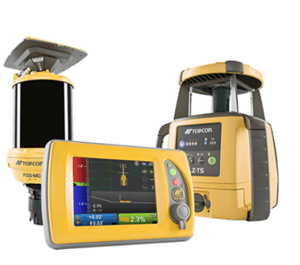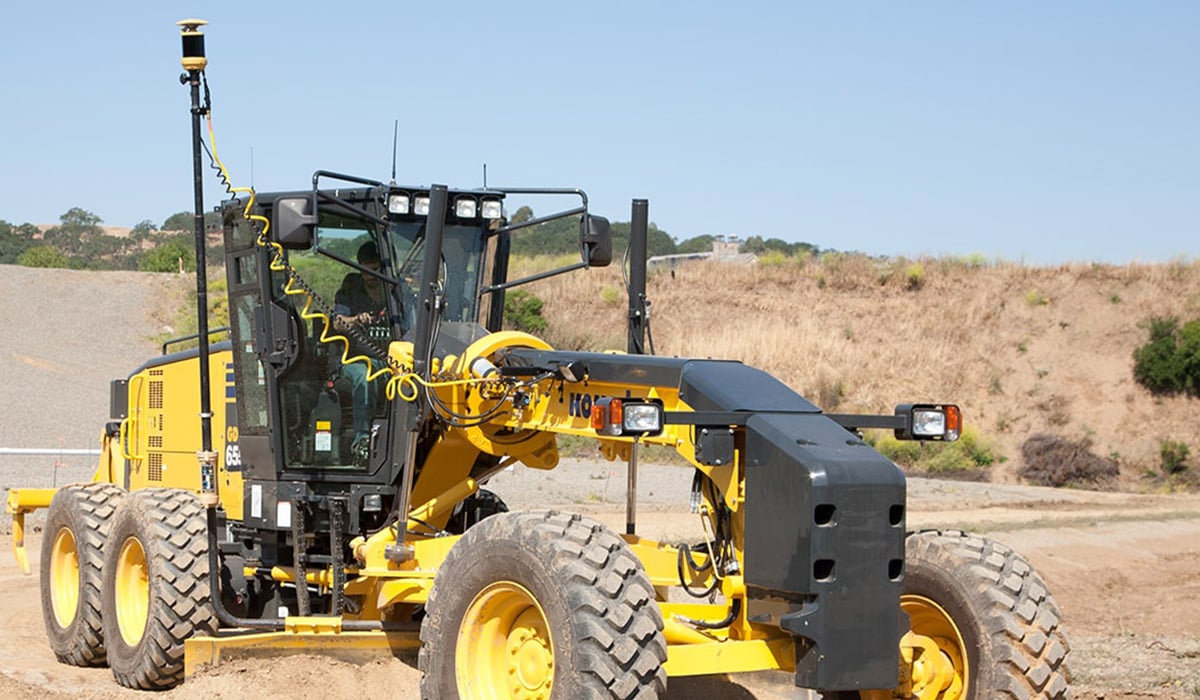More Precision for your Grader, with Less Man-Hours
One of the most exciting and increasingly utilised technological advancements in the construction sector are GPS machine control systems.
Traditionally, graders are used in civil engineering to prepare a wide, flat base course for a final road surface, requiring the angle, tilt (or pitch) and height of the grader's blade to be adjusted to achieve a high level of precision.
Typically, this would require extensive surveying, manual operation of the grader itself by a trained grader operator, physically surveying all control points, traditional methods such as stakes and string lines, as well as a significant amount of man hours costing construction companies time, money and resources.
Over the past few years, positioning system companies such as Topcon have been developing technology that allows Civil Engineers to use GPS guidance technology to deliver solutions that are superior to the competition, through the application of these management systems.
In this blog, we cover the way GPS machine control systems afford a high level of accuracy, examples where these systems have been used with graders here in New Zealand to improve the delivery of major projects, and finally, showcase the pick of the bunch for grader optimisation; Topcon mmGPS+ control for Grader.
How GPS Machine Control Works
Machine control systems essentially use satellite signals to provide accurate and real-time information to grader operators about a job site, as they're working on a job. The GPS data then creates a digital topo (otherwise known as a survey) that maps out changes in elevation and gradient on the construction site.
Doing this work manually would take a staggering amount of time, where as state of the art GPS machine control systems automate the process completely, saving extensive amounts of time and money.
Different Types of Grade Control Systems
-
1D Control Systems
A one dimensional control system uses lasers to achieve control, however it's an 'indicator only' system where operator is alerted when a predetermined grading contour has been achieved or exceeded. This should only be used on very basic jobs looking for a rougher finished, as opposed to precise finishing touches.
-
2D Control Systems
Two dimensional systems can operate on both a slope and a plane, using lasers, sensors and reference points to regulate elevation. A system such as Topcon 2D control for grader is a good example of this, as it gives the flexibility to use reference to work from: existing surface, a previous cut, curbstone or a string line, with a professional finish.
With 2D motor grader sonic control, you’ll eliminate over cutting and control material usage saving you time and money. With these systems the operator is really in control. slope, elevation, speed and efficiency.
-
3D Control Systems
Last but not least, the most cutting edge technology is the 3D control system. A 3D grade control system is a high-tech option that uses a series of laser-guided sensors, GPS or GNSS satellite signals and worksite topography to carry out complex grading work with absolute accuracy.
The State of the Art: Topcon mmGPS+ control for Grader

The Topcon mmGPS+ control uses satellite positioning based 3DMC GPS+ or standard robotic total station based 3DMC LPS motor grader grade control to achieve superior performance, follow complex designs, show viewable blade positioning and offer increased safety.
In essence, 3DMC enables the operator to “see” multiple machine’s exact position within the site.
In plain speak, Satellite signals tell your machines exactly where they are on the job at all times, a 3D model or blueprint then tells them to rise or fall to meet the grade perfectly every single time.
The best part is, there are no other references necessary to achieve this. No stakes, no string lines, no total stations and full automation.
Through this incredibly accurate and unique technology, error is reduced to 9mm or less - that means unbelievable accuracy on a large scale, compared to the typical manual processes of 1D and 2D technology.
Case Study: CityEdge Alliance & the Hamilton section of the Waikato Expressway

CityEdge Alliance is a group of who worked together on the 22 km four-lane Hamilton section of the Waikato Expressway, from the Ngāruawāhia section of the expressway to the Tamahere and Cambridge sections.
The complex project involves the construction of 17 bridges crossing nine local roads, three deep gullies and a busy railway line carrying 30 to 40 trains a day to and from Tauranga - so you can imagine the intricacies of this, across multiple companies and kilometres of road.
"With so many crews on site and parts of the project happening at once, accuracy and efficiency are incredibly important," - Mike Graham, from Alliance partner Higgins
The pavement team on the project has used the Topcon Millimeter GPS+ system on four of its Cat 12M graders (along with other Topcon GPS equipment on its diggers). It’s was the first time they’ve used the mmGPS.
For paving, it provides the speed and flexibility of GPS, with more than three times the accuracy.
The system uses special lasers transmitting over 400m and 20m high, so the Alliance paving team is using four of them over 600m, with four graders and four mm survey rovers hooked on to the same system. Tolerances are now only 1 to 5mms – something that would take four times as long to achieve with string lines.
"Can you imagine if we were using string lines and needed a surveyor every 20 metres or so for 22 kms – on both sides? With an intolerance of 5mms?! That quickly adds up. This way we’re better, faster, cheaper and more accurate."
The outcome?
As Graham astutely put himself; "I’ve been doing this kind of work for 25 years and can’t believe we haven’t used anything like this before."
Innovative technology and automated processes are shaping the future of construction, and if you don't have the right tools in place, you risk being left behind. Want to know? Download the FREE Guide to Connected Construction below.



